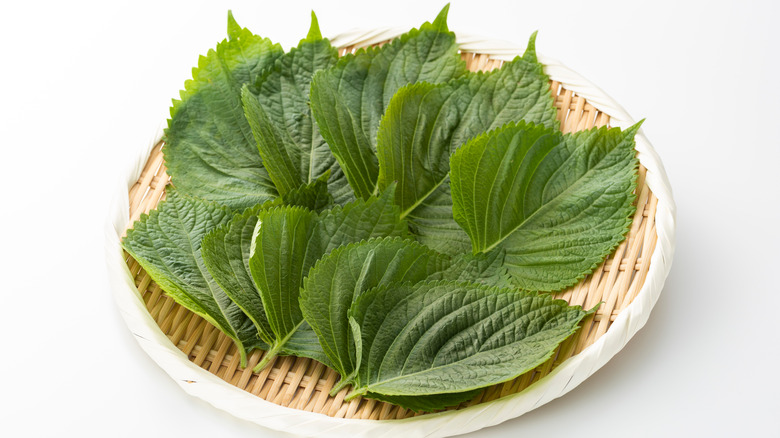The Versatile Herb You Can Always Find At H-Mart
There are many uniquely Korean ingredients that are essential for making such dishes as bulgogi, bibimbap, kimbap, and pajeon, but some are easier to find than others when shopping outside of their native land. H-Mart, a national grocery store chain specializing in all things Korean, carries these essential cooking ingredients, from gochujang that can be found on most major grocery store shelves to the hard-to-find mihyang (cooking wine), according to Food & Wine.
If you go to your local grocery store, you may find soy sauce in the Asian food aisle, but it's doubtful that it's the Korean version. While there are many ingredients that are common between Asian cultures, such as soy sauce and sesame oil, the Korean versions are a little different. Korean cooking wine, for instance, is similar to Japanese vinegar or mirin, Chef Deuki Hong told Food & Wine, but Korean mihyang is sweeter. Korea's version of soy sauce is called ganjang and is made only from salt, soy beans, and water (no wheat) while Japanese soy sauce has some wheat and Chinese dark soy sauce contains sugar or molasses, according to Matador Network.
If a truly authentic-tasting bowl of Korean bibimbap or kimbap roll is what you want to make, shopping at a Korean store is the best thing to do.
A flavorful leaf for Korean cooking
Found at specialty grocery stores and always at H-Mart, kkaennip or perilla leaf, is a versatile ingredient that can be used in many different ways in the kitchen. Maangchi likes to steam perilla leaves for a dish called kkaennipjjim. Korean Bapsang transforms the leaves into a quick kimchi using fish sauce, soy sauce, sesame seeds, and gochugaru, among other ingredients. The kkaennip plant is commonly grown at homes in Korea, according to Korean Bapsang, and its seeds can be harvested in the fall.
Perilla, according to The Takeout, is a member of the mint family that has a minty scent and a flavor that tastes a little like licorice. The most common uses for kkaennip are to wrap pieces of meat cooked during a Korean barbecue or broken up and incorporated into soups, per Chef Deuki Hong. Korean Bapsang lists other uses as being added to savory pancakes or added to kimbap. A summery use for perilla leaves is pickled in soy sauce, according to Kimchi Mari. By pickling the leaves, they become a tasty banchan (side dish) that can be served with a variety of meals, including Korean barbecues.
Next time you find yourself in H-Mart pick up a package of the versatile kkaennip. Or even add the plant to your garden as The Takeout suggests due to its many uses.

